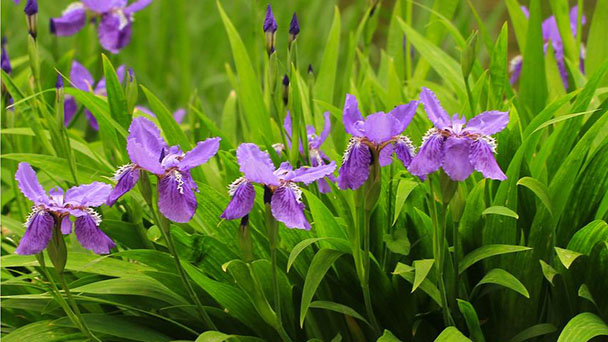Iris L profile
Written by Maggie
Nov 17 2020

Iris L is large and beautiful, with verdant leaves and high ornamental value. Many species are used for garden viewing. In the garden, it can be used to arrange flower beds, planted on wet grounds, poolside lakes, or arranged as Iris L specialized gardens. It can also be used as cut flowers and ground cover plants. It is an important garden plant.
Iris L picture

Iris L morphological characteristics
Iris L is a perennial herb. The rhizomes are long strips or lumps, extending horizontally or obliquely, slender or thick. The leaves are multiple basal, nested, arranged in 2 rows, sword-shaped, striped or filamentous. Leaf veins are parallel, midrib is obvious or absent, base sheath-like, and tip acuminate. Most of the species have only flower stems without obvious above-ground stems. The flower stems are drawn from the leaf clusters. Most species extend out of the ground, a few are shortened and do not extend. The top is branched or unbranched; the inflorescence is born on the top of the branch or only 1 flower grows at the top of the flower stem; several bracts grow at the base of the flower and inflorescence, membranous or herbaceous. The flower is larger, blue-purple, purple, red-purple, yellow, white; perianth tube trumpet-shaped, filamentous or very short and inconspicuous, 6 perianth lobes arranged in 2 rounds, 3 outer perianth lobes, often larger than those of the inner ring. The upper part is often reflexed and drooping, and the base is claw-shaped, most of which are groove-shaped, smooth, and no appendages or have coryneform and beard-like appendages, 3 inner tepal lobes, erect or oblique outward; stamens 3, inserted at the base of outer tepal lobes, anthers dehiscing outward, flower two filaments separated from the base of style Unripe.The style of the pistil is single, the upper part is 3 branches. The branches are flat, arched and curved, with bright colors, petal-like, and the top is 2-lobed, the lobes are semicircular, triangular or narrowly lanceolate. The stigma is born on the style The base of the apical lobes is mostly semicircular, tongue-shaped, inferior ovary, 3-loculed, axial placenta, with many ovules. Capsules are elliptical, ovoid or round, with beak or absent at the tip, and the dorsal cavity is cracked when mature; seeds are pear-shaped, flattened semicircular or irregular polyhedrons, with appendages or absent.
Iris L growth habit
Iris L generally has dormancy characteristics, and the germination of Iris L is very different. Some kinds of seeds can germinate quickly, and some kinds of seeds often need about 1 year of dormancy to germinate under natural conditions, and germination is slow.

Geographical distribution of Iris L
There are about 300 species of Iris L in the world, distributed in the northern temperate zone; about 60 species, 13 varieties and 5 varieties are produced in China, mainly distributed in the southwest, northwest and northeast.
Iris L main value
Watch
Most of Iris L has high ornamental value and strong resistance to adversity, and its wide adaptability, especially its role in garden construction and huge application prospects, has attracted more and more attention. There are more than 20,000 species of kite Iris L in the world. According to its living habits, phenological period and flower color, using it as a material, scientifically and rationally carry out the scenery and greening of land and aquatic ecological landscapes to give full play to its posture. The natural beauty such as rhyme, line and color can achieve the effect of creating landscape and beautifying the environment, providing a good place for rest and tourism.
In addition to being used as a flower in gardens, Iris L has medicinal value. Iris L is pungent, bitter and cold in nature, and can be used to treat rheumatic pain and bruises; the root of Iris L in Nepal can be digestive and diuretic; the Iris L is sweet and flat in nature. It is used for treating jaundice, diarrhea, vomiting blood, bleeding, and sore throat. Iris L extract can also treat atherosclerosis and osteoporosis. In addition, there are several kinds of Iris L rhizomes, which can extract a precious essence. If it is ground directly into a powder, it will be a fine powder.

Latest Updated
- Benefits of Bugleweed - 7 Science-backed Health Benefits
- Bugleweed Dangers & Side Effects - Is It Poisonous?
- How to Plant Evergreen Trees - What You Should Know
- When to Plant Evergreens - Grow Guide for Evergreen Trees
- 12 Wonderful Evergreen Shrubs for Your Garden
- 12 Popular Evergreen Plants with Pictures for Beginners
- When And How To Prune A Lilac Bush Like a Pro
- How to Grow & Care for Lilac Vine (Hardenbergia Violacea)
- Japanese Lilac Tree (Syringa Reticulata) Care & Propagation Guide
- Shumard Oak Pros and Cons - What to Know
Popular Articles
- Winter maintenance of Antirrhinum Majus
- How to Grow Terminalia Mantaly Tree
- How to Grow and Care for Crossostephium Chinense
- How to grow Antirrhinum Majus in spring
- Peristeria Elata (Dove Orchid) Profile: Info & Care Guide
- Underwatered Snake Plant (Sansevieria Trifasciata) - Signs And How To Fix
- How to Care for Brazilian Jasmine Plant (Mandevilla Sanderi)
- How to Grow & Care for Graptopetalum Purple Delight in Summer
- Rosa Chinensis (China Rose): Plant Growing & Care Tips
- How to Care for Baby Sun Rose (Aptenia Cordifolia)